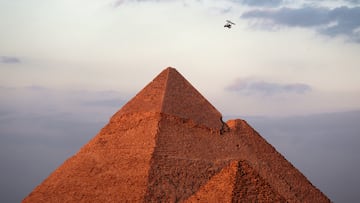Róisín Heneghan, architect, on the Grand Egyptian Museum: “We wanted visitors to appreciate the scale of the collection”
The doors are now open at the Grand Egyptian Museum, a $1 billion attraction overlooked by the Pyramids of Giza.


Twenty years after construction began, having reportedly cost more than $1 billion to build, the Grand Egyptian Museum (GEM) this month opened its doors to visitors.
Housing over 100,000 artifacts, the GEM is “a testament to the longevity and scale of ancient Egyptian civilization and its enduring influences”, the museum’s architects said in a press release this month.
The GEM was officially inaugurated in a lavish ceremony on November 1, Egyptian president Abdel Fattah al-Sisi declaring: “Today, as we celebrate together the opening of the Grand Egyptian Museum, we are writing a new chapter in the history of the present and the future.”
Such was the anticipation surrounding the GEM’s opening that November 1 was declared a national holiday in Egypt.
“The grandeur of ancient Egyptian civilization”
Designed by the Dublin-based Heneghan Peng Architects (HPARC), the GEM is billed as the world’s largest archaeological museum dedicated to a single civilisation.
It tells the story of ancient Egypt from prehistory to the Greek and Roman periods, across a 5.4-million-square-foot site that blends “the grandeur of ancient Egyptian civilization with cutting-edge museum technology”, the GEM says.
Situated on the Giza Plateau, around 10 miles outside Cairo and less than two miles from the Great Pyramids, the GEM boasts vast exhibition spaces within a futuristic, alabaster-and-glass structure that’s rich in natural light.
On entrance, visitors find themselves inside an imposing grand hall dominated by a huge, 80-ton statue of the Egyptian pharaoh Ramesses II. The statue “stands as a testament to ancient Egyptian craftsmanship and power”, the museum says.
Beyond the grand hall lies a 20,000-square-foot staircase that brims with artifacts. At the top of the stairs, visitors are treated to a stunning view of the Great Pyramids.
The GEM has six permanent galleries, plus four temporary exhibitions. A highlight is a collection of nearly 5,400 objects, presented together under one roof for the first time, relating to the Egyptian pharaoh Tutankhamun. The exhibit includes “King Tut’s” iconic golden burial mask.
Take a video tour of the GEM:
A perennially-delayed project
A project first announced in 1992, construction on the GEM began in 2005. Two years earlier, HPARC - then a firm that employed just four people - had been awarded the project by the Egyptian Ministry of Culture. The company was chosen ahead of over 1,500 competitors from more than 80 countries.
Speaking to CNN last month, HPARC co-founder Róisín Heneghan recalled that she phoned the ministry straight back after being told her firm had secured the contract. Heneghan had to make sure she hadn’t just been the victim of a practical joke.
“It was unreal,” she told CNN. “We got the call, and I put down the phone - because in those days, it was all by phone or by letters and post - and I said, ‘I think we won.’”
Originally slated to open in 2011, the GEM was hit by numerous delays, due to factors such as the Arab Spring uprising and the covid-19 pandemic. However, the museum finally had its soft launch in October 2024, before opening to the public at the beginning of this month.
Aside from its sprawling indoor floor space, the GEM includes vast outdoor exhibition areas - five hectares in total.
“Dialogue between museum and pyramids”
“We wanted visitors to appreciate the scale of the collection‚” Heneghan told CNN of HPAC’s design for the GEM. In its recent press release, the firm added that it sought to establish a “direct dialogue between the museum and the pyramids”.
“The museum structure radiates outward toward the pyramids along a visual axis that aligns directly with the positioning of the three pyramids,” HPARC said.
The GEM’s design “makes the pyramids feel like a part of the museum itself”, the firm concluded.
Related stories
Get your game on! Whether you’re into NFL touchdowns, NBA buzzer-beaters, world-class soccer goals, or MLB home runs, our app has it all.
Dive into live coverage, expert insights, breaking news, exclusive videos, and more – plus, stay updated on the latest in current affairs and entertainment. Download now for all-access coverage, right at your fingertips – anytime, anywhere.


Complete your personal details to comment